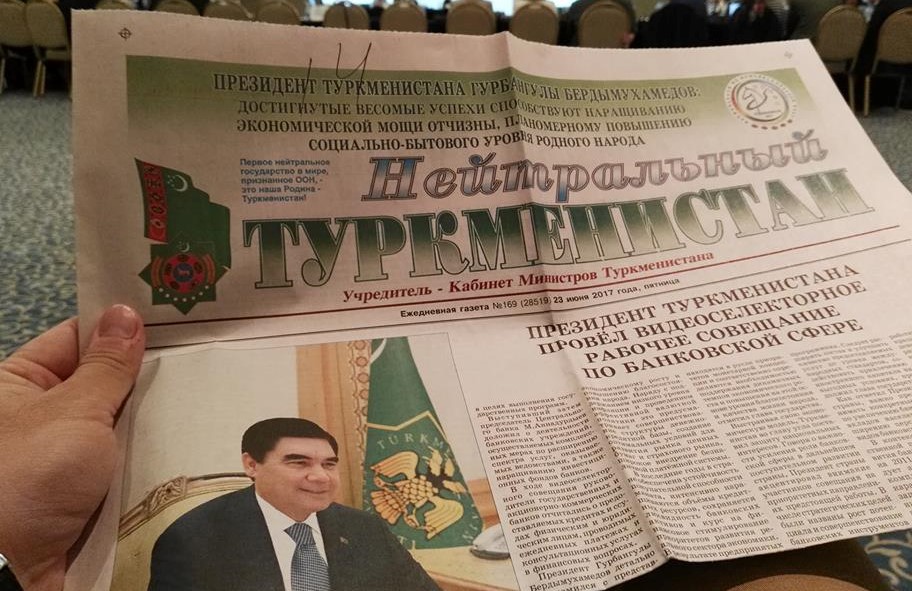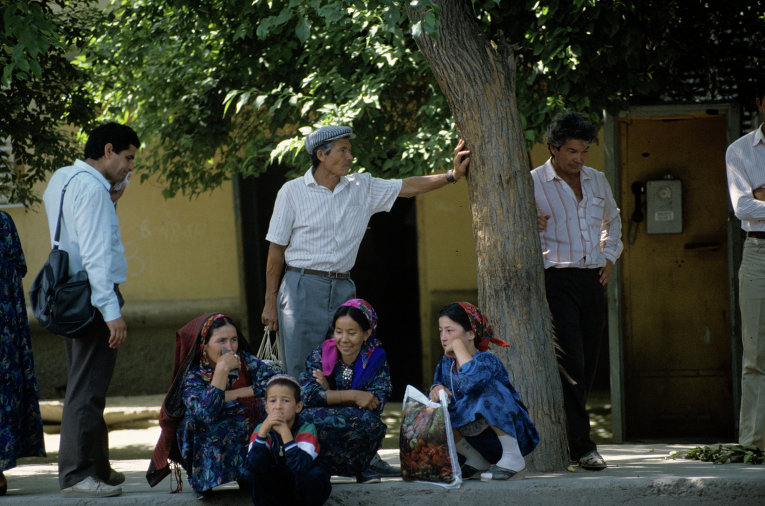“Just like the Karakum [Desert], the Turkmen information field is full of life despite its apparent lifelessness. Turkmenistan has two information fields, two information environments. One is sterile and has dead orderliness; another one has chaos and productive energy of communication,” a Turkmen analyst wrote in the article specifically for CABAR.asia.
РусскийFollow us on LinkedIn
Brief review of the article:
- The problem of state-run media is largely in the language of coverage, and also in the non-relevant information;
- The key attempt of the government to restrict access to foreign media is a campaign to demolish satellite dishes;
- The so-called “opposition media” are often related to human rights organisations rather than to the political opposition;
- Despite numerous bans, internet users in Turkmenistan show high adaptability and resourcefulness.

Turkmenistan, along with other properties of an authoritarian state, is known for its suspicious attitude towards exchange of information. The country practices strict media censorship, the police disapprove of photo and video shooting, and public statements by citizens can lead to real consequences. This article will study the processes of information exchange in Turkmenistan, where flexible and curious processes of communication emerge within a rigid and restricted information environment.
State-run media and their satellites Five old men sit in a studio with an “acidic” animation in the background. Men’s hands of men are decorously resting on an amazingly-shaped table. Moderately, yet with enthusiasm, one of the men specifies the economic achievements of Turkmenistan. In his speech he mentions factories, plants, sports facilities, cotton producers and libraries. After a few minutes of viewing of such a TV programme, you have a feeling that the participants read out some endless and meaningless text. This is what an average “talk show” on a Turkmen TV channel looks like. Things are no better with the Turkmen press. For an average person, each new issue of a newspaper (for example, the Russian-language “Neitralny Turkmenistan” [Neutral Turkmenistan]) resembles a previous issue. Finally, the portrait, or, more precisely, the subject of the portrait on the front page has not changed for a decade. As for the content of the Turkmen press, it can be assessed by such phrases as, “The success of the cotton producers is the result of joint efforts of all agricultural producers and the logical result of large-scale transformations carried out in the industry as part of the agrarian reform initiated by president Gurbanguly Berdymukhamedov.” The state-run media of Turkmenistan, although they seem to be a direct legacy of the Soviet era, are nevertheless a more modern phenomenon. Unlike Soviet journalism, which allowed for at least some debates in the information field, the Turkmen media use the distilled language of a Kafkaesque bureaucracy. Thus, the weak spot of the Turkmen state-run media is, first of all, the absence of a lively language that can get a feedback in the society. Despite the ubiquitous official propaganda, we can see the inefficient strategic communication of state-run media. With very few exceptions, the official propaganda falls on deaf ears of citizens. However, one of such exceptions is the music channel Turkmen Owazy, which is very popular among the population of Turkmenistan. Unlike the majority of TV and radio channels, Turkmen Owazy receives feedback from its audience via game shows. Thus, one of its radio shows receives calls in live mode in a kind of a “Name that tune” show. Turkmen young people recognise popular hits literally in three notes, and the winners can finally select the next song. In this case it’s obvious that the “soft” orientation of the channel provides an opportunity for a lively and natural communication. The problem of state-run media is largely in the language of coverage, and also in the non-relevant information. The discourse of the national press remains inscrutable to the majority of audiences and is compulsory, not understandable. Things are no better with the so-called “pro-government media” that keep to the official agenda, but cover “softer” stories. Despite their independent status, similar media run errands for the authorities. Thus, the campaign on covering “food abundance” in the markets of Turkmenistan was launched in opposition to foreign media reports about the crisis in the country. In the 1990s, the abbreviation TMT (in Turkmen language – Turkmenistan National Television) was interpreted as “your dead TV” (твой мертвый телевизор). Later on, TV channels were renamed as more dignified Golden Age (Altyn Asyr), Youth (Yaslyk), Heritage (Miras). However, “television” has not come to life after that and remains a white noise in the information field of the country. Foreign media Satellite dishes installed on rooftops of citizens have recently been the hallmark of Turkmenistan. Numerous dishes pointed in one direction were a mass sign of information search. In the nineties, the population of Turkmenistan found a new way of receiving information via satellite antennas. Such antenna and a tuner gave access to a number of foreign channels, which were unavailable earlier. The most popular channels were Russian and Turkish channels. Foreign media were obviously popular due to the low quality of state-run media. Unlike television, foreign press is not very popular. In 2005, Saparmurat Niyazov banned import and distribution of foreign press in the country. Thus, for example, popular outlets that published TV programmes, as well as Times of Central Asia newspaper were banned. The distribution of print media seems to be under easy control of the state apparatus. It should be noted that the markets of Turkmenistan have points of sale of foreign, usually Russian press. Often it is entertaining materials that can be found near Russian book products. The key attempt of the government to restrict access to foreign media is deemed a campaign to demolish satellite dishes (in addition to internet blocks). The researcher of media space, Lisa Parks, sees one of the causes of such decision in the coverage of the fire at the army depot at the city of Abadan, which took place in 2011. Some Russian media reported the July fire, which resulted in the ammunition explosions, which could cause the discontent of the president. Parks has called the satellite dish “an intermediate feedback circuit”, which returns information to Turkmenistan via the mobile communication and international satellite network.
There is another point of view regarding the demolition of satellite dishes – aesthetical one. This is the case of the preferences of the key “patron” of Turkmenistan. The authorities have repeatedly made it clear that satellite antennas spoil the image of the capital city. By the way, this has been the reason why the authorities have recently demolished air conditioners from the facades of buildings. This hypothesis can be based on two explanations. President Berdymukhamedov tends to see the capital city from the helicopter and residential buildings with a variety of satellite dishes on them could have perplexed the national leader because they ensure access to information avoiding government censors. This could be the reason for the implementation of such campaigns mainly in Ashgabat. Moreover, since 2014, the state has offered an alternative IP-television at an affordable price (10 manats per month = 2.8 dollars at the official exchange rate, 0.5 dollars at the unofficial rate). The package of channels includes Russian channels, international news channels (Euronews, BBC), Turkish channels, as well as various entertaining TV channels. It’s quite possible that the authorities don’t mean to restrict access to foreign media outlets as such, but rather try to prevent a leak of information about troublesome events in the country and dissemination of this data among people via international media.
The so-called “opposition media”, the majority of which are the projects of human rights organisations and foreign foundations for the country’s democratisation, can be distinguished here. The vast majority of such media are online media outlets, sometimes having pages in social networks. Access to such media is limited; moreover, intelligence agencies identify citizens who visit inappropriate websites. Despite the prevalence of anonymisers and means of accessing blocked websites, these websites are not frequently used because of the theoretical risk of being tracked. When discussing the news, the Turkmenistanis try not to mention such sources, which is the reason for such an isolated audience of the dissident press in the country. Tariffs for urban residents and tariffs for rural citizens Internet is the most vulnerable point of communication in Turkmenistan. The country has often had low rankings on the internet freedom list. However, Gurbanguly Berdymukhamedov is known for having improved the situation with the internet. First of all, the president has eased restrictions on connection to the “worldwide web” to individuals. Secondly, relatively cheap rates of quicker connection have emerged with Berdymukhamedov (before that, citizens could use only dial-up connection), and mobile internet has become widely spread. The introduction of unlimited ADSL tariffs in 2012 has contributed to the significant growth of internet connections. The most popular tariff was 128 kbps. This tariff, despite its relatively high price (100 manats = 35 US dollars at the 2012 rate), was more cost-efficient than the 2Gb-limit tariff at the speed of 64 kbps, which cost 30 dollars. Now the unlimited tariff with the lowest speed (256 kbps) costs 150 manats in the cities (these tariffs are weirdly called “for the population”) and 75 manats in the villages (tariffs “for velayats”). Thirdly, with Berdymukhamedov Turkmenistan has seen the period of relative material well-being, which allowed many citizens purchase mobile phones with internet access.
As in any other state with restricted access to information, rumours gain more importance in the society and depending on their significance circulate throughout the country; sometimes, rumours can be spread by the government.
The most popular rumours are about relevant problems of an average citizen of Turkmenistan – dollar exchange rates, escalation in prices, all kinds of bans. The state does not provide clear information to the population and, generally speaking, the people in Turkmenistan are unaware of domestic policy issues. Rumours just like air bubbles rise to the surface of information field and then fly through homes, offices, markets and households. Also rumours can be told by a relative, friend, taxi driver, seller, or even a local police officer.This article was prepared as part of the Giving Voice, Driving Change – from the Borderland to the Steppes Project implemented with the financial support of the Foreign Ministry of Norway. The opinion expressed in the article does not reflect the position of the editorial board or the donor.

